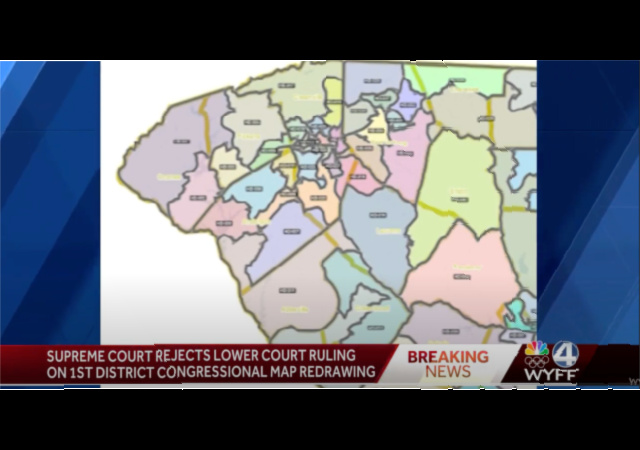Supreme Court Upholds South Carolina Voting Map as Constitutional

The Supreme Court upheld the GOP-drawn South Carolina voting map as constitutional by a 6-3 vote.
The ACLU and NCAAP claimed the GOP illegally redrew the voting map after 2020.
A district court overturned the South Carolina map, claiming the 1st Congressional District “was an unlawful gerrymander” because the Republicans “shifted about 30,000 Black voters from Charleston County over to the state’s 6th Congressional District, which became more solidly Democratic than it was before.”
Rep. James Clyburn (D-SC) holds the 6th Congressional District.
South Carolina already held its presidential primary. The state has June primaries, though, and early voting begins for that begins on May 28.
The map is important:
All seven of South Carolina’s seats in the U.S. House of Representatives are up for election in 2024.All 170 seats in the South Carolina state legislature — 124 in the House and 46 in the Senate — are also up for grabs this year. But, not every race features a contested primary.
Justice Samuel Alito wrote:
They [the challengers] provided no direct evidence of a racial gerrymander, and their circumstantial evidence is very weak. Instead, the Challengers relied on deeply flawed expert reports. And while these experts produced tens of thousands of maps with differently configured districts, they did not offer a single map that achieved the legislature’s partisan goal while including a higher BVAP in District 1. Faced with this record, we must reverse the District Court on the racial-gerrymandering claim.
Justice Clarence Thomas sided with the majority, but did not agree with Part III-C. Thomas does not think SCOTUS has the power to decide the two claims listed in that part: a “racially-gerrymandering” claim and a “vote dilution” claim.
“Drawing political districts is a task for politicians, not federal judges,” Thomas argued. “There are no judicially manageable standards for resolving claims about districting, and, regardless, the Constitution commits those issues exclusively to the political branches.”
Thomas has an interesting view regarding the Court’s approach to these cases, telling his colleagues to take the bait when they participate. He brings up a familiar recent case:
The Court’s insistence on adjudicating these claims has led it to develop doctrines that indulge in race-based reasoning inimical to the Constitution. As we reiterated last Term, “‘[o]ur Constitution is color-blind.’” Students for Fair Admissions, Inc. v. President and= Fellows of Harvard College, 600 U. S. 181, 230 (2023) (quoting Plessy v. Ferguson, 163 U. S. 537, 559 (1896) (Harlan, J., dissenting)). A colorblind Constitution does not require that racial considerations “predominate” before subjecting them to scrutiny. Nor does it tolerate groupwide judgments about the preferences and beliefs of racial minorities. It behooves us to abandon our misguided efforts and leave districting to politicians.
The three liberal justices dissented. Justice Elena Kagan wrote:
In every way, the majority today stacks the deck against the Challengers. They must lose, the majority says, because the State had a “possible” story to tell about not considering race—even if the opposite story was the more credible. Ante, at 16. And they must lose again, the majority says, because they failed to offer a particular form of proof— which they did not know would be relevant and which this Court recently told plaintiffs was not required.
CLICK HERE FOR FULL VERSION OF THIS STORY